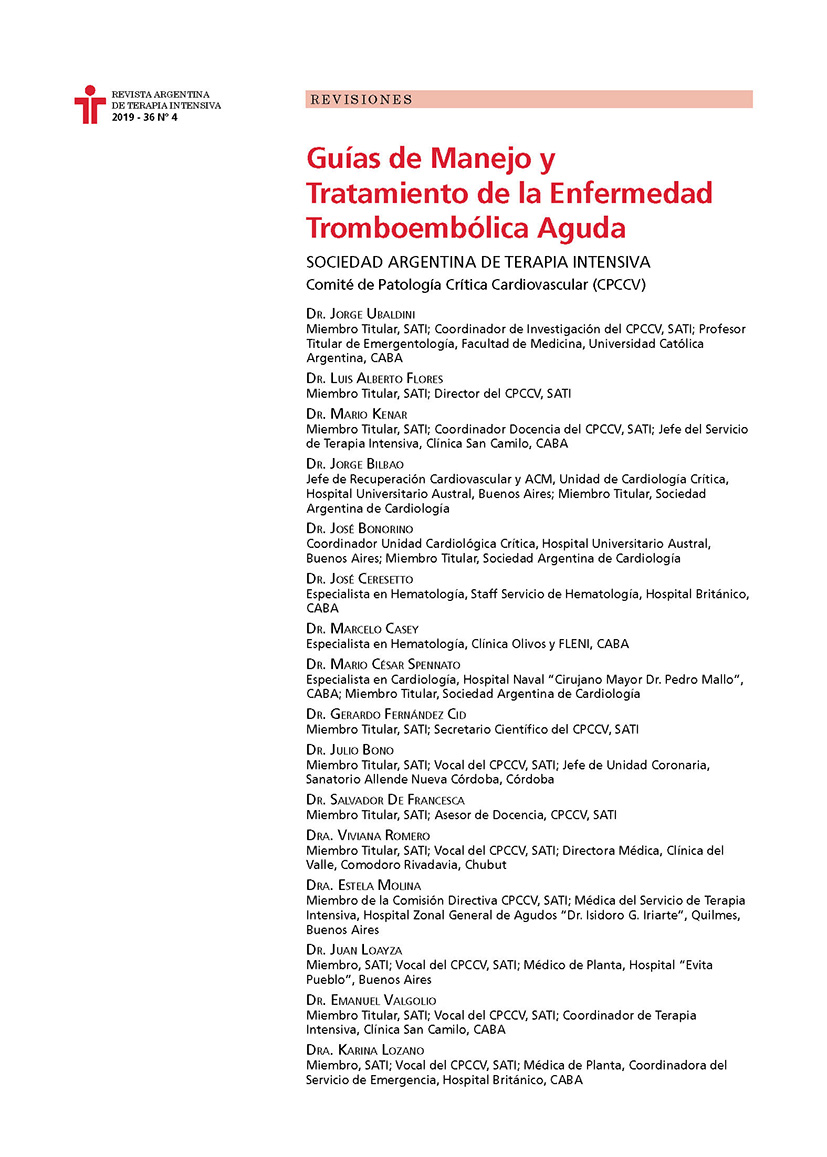Guías de Manejo y Tratamiento de la Enfermedad Tromboembólica Aguda
Contenido principal del artículo
Resumen
El tromboembolismo de pulmón (TEP) es una urgencia cardiovascular de una incidencia anual de 70 casos por cada 100.000 habitantes. La frecuencia anual de aparición de la enfermedad se acrecienta en personas añosas y a su vez se incrementa frente a la presencia de múltiples comorbilidades.
El pronóstico de la enfermedad puede variar ampliamente dependiendo de la forma de presentación. Dentro de este amplio abanico de posibilidades encontramos en uno de los extremos al TEP de alto riesgo con elevada mortalidad y en el otro extremo al TEP de bajo riesgo con escasa repercusión hemodinámica de baja mortalidad.
Habitualmente la presentación clínica es poco específica y frecuentemente se asocia a otras patologías con signos y síntomas que se superponen, generando demoras diagnósticas.
La mayoría de los eventos de embolia pulmonar están relacionados con la trombosis venosa profunda (TVP) proximal de los miembros inferiores. Esta entidad se asocia a condiciones que determinan hipercoagulabilidad sanguínea, tanto congénitas como adquiridas, sin embargo un porcentaje significativo de pacientes presentan enfermedad tromboembólica (ET) sin que se pueda establecer un factor predisponente.
Detalles del artículo
La revista no retiene los derechos de reproducción (copyright) por lo que los autores pueden volver a publicar sus trabajos con la sola mención a la fuente original de publicación.
Citas
Tapson VF Acute pulmonary embolism. N Eng J Med 2008;358:1037
2014 ESC Guidelines on the diagnosis and management of acute pulmonary embolism. The Task Force for the Diagnosis and Management of Acute Pulmonary Embolism of the European Society of Cardiology (ESC) Endorsed by the European Respiratory Society (ERS) Authors/Task Force Members: Stavros Konstantinides (Chairperson) (Germany/Greece), Adam Torbicki 23Heart Journal doi:10.1093/eurheartj/ehu283
Consenso de Enfermedad Tromboembólica Aguda Rev Argent Cardiol 2016; 84:371
Stein PD, Beemath A, Matta F y otros. Clinical characteristics of patients with acute pulmonary embolism: data from PIOPED II. Am J Med 2007; 120:871
Carson JL, Kelley MA, Duff A. The clinical course of pulmonary embolism. N Eng J Med 1992; 326:1240.
V, Aizpuru F, Uresandi F, Garcia-Bragado F, Conget F, Monreal M. Clinical syndromes and clinical outcome in patients with pulmonary embolism: findings from the RIETE registry. Chest. 2006; 130:1817–1822.
Goldhaber SZ, Visani L, De Rosa M. Acute Pulmonary Embolism:clinical outcomes in the International Cooperative Pulmonary Embolism Registry (ICOPER). Lancet 1999;353: 1386
Jiménez D, Aujesky D, Moores L, Gómez V, Lobo JL, Uresandi F, et al., for the RIETE investigators. Simplification of the Pulmonary Embolism Severity Index for prognosticating patients with acute symptomatic pulmonary embolism. Arch Intern Med. 2010;170:1383
Diagnostic prediction models for suspected pulmonary embolism:systematic review and independent external validation in primary care. Hendrksen JMT, Geersing GJ, Lucassen WAM. BMJ 2015; 351: h4438
NT-Pro BNP levels in patients with acute pulmonary embolism are correlate to right but not left ventricular volume and function. Pasha SM, Klok FA, van der Bill N et al. Thromb Haemost 2012; 108(299. 367
Palmieri V, Gallotta G, Rendina D, De Bonis S, Russo V, Postiglione A,Martino S, Di Minno MN, Celentano A. Troponin I and right ventricular dysfunction for risk assessment in patients with nonmassive pulmonary embolism in the Emergency Department in combination with clinically based risk score. Intern J Emerg Med. 2008;3:131–138.
Lee DW, Gopalratnam K, Ford HG 3erd. The value of bedside echocardiogram in the setting of acute and chronic pulmonary embolism. Clin Chest Med 2018; 398(3): 549
Moore AJE, WachsmannJ, Chamarty MR et al. Image of acute pulmonary embolism: an update. Cardiovasc Diag Ther 2018; 8(3): 225
A clinically meaningful interpretation of the prospective investigation of pulmonary embolism (PIOPED) II and III data. Cronin P, Dwamen BA. Acta Radiol 2018; 25(5): 561
Woo KM, Goetz JK. Diagnosis and management of deep venous thrombosis in the Emergency Department. Emerg Med Pract 2015; 17(3): 1
Howard LSGE, Barden S, Condliffe British Thoracic Society Guideline for thr initial outpatient management of pulmonary embolism (PE) Thorax 2018; 73: ii1
Chatterjee S, Chakraborty A,Weinberg I, Kadakia M, Wilensky RL;Sardar P, Kumbhani DJ, Mukherjee D, Jaff MR, Giri J. Thrombolysis for pulmonary embolism and risk of all-cause mortality, major bleeding, and intracranial hemorrhage. A meta-analysis. JAMA 2014;311:2414-2421
Zamanian RT, Haddad F, Doyle RL. Management strategies for patients with pulmonary hypertension in the intensive care unit. Crit Care Med 2007; 131: 1917
Bouferracche K, Vieillard-Baron. Acute respiratory distress syndrome, mechanical ventilation and right ventricular function. Curr Opin Crit Care 2011; 17: 30
Meyer G, Vicaut E, Danays T, et al; PEITHO Investigators. Fibrinolysis for patients with intermediate-risk pulmonary embolism. N Engl J Med 2014;370:1402-1411.
Marti C, John G, Konstantinides S, Combescure C, Sanchez O, Lankeit M, Meyer G, Perrier A. Systematic thrombolytic therapy for acute pulmonary embolism: a systematic review and meta-analysis. Eur Heart J (2014) doi: 10.1093/eurheartj/ehu218 First published online: June 10, 2014
Sharifi M, Bay C, Skrocki L, Rahimi F, Mehdipour M. Moderate pulmonary embolism treated with thrombolysis (from the “MOPETT†Trial). Am J Cardiol 2013;111:273-7.
Chatterjee S, Chakraborty A,Weinberg I, Kadakia M, Wilensky RL;Sardar P, Kumbhani DJ, Mukherjee D, Jaff MR, Giri J. Thrombolysis for pulmonary embolism and risk of all-cause mortality, major bleeding, and intracranial hemorrhage. A meta-analysis. JAMA 2014;311:2414
RuÃz-Giménez N, Suárez C, González R, Nieto JA, Todolà JA, Samperiz AL, et al., RIETE Investigators. Predictive variables for major bleeding events in patients presenting with documented acute venous thromboembolism. Findings from the RIETE Registry. Thromb Haemost. 2008;100:26-31.
Nassiri N, Jain A, McPhee D. Massive and submassive pulmonary embolism experience with an algorithm for catheter-directed mechanical thrombectomy. Ann Vasc Surg 2012; 26: 18
Eid-Lidt G, Gaspar J, Sandoval J. Combined clot fragmentation and aspiration in patients with acute pulmonary embolism. Chest 2008;134: 54
Lee T, Itagaki S, Chiang GP et al. Survival and recurrence after acute pulmonary embolism treated with pulmonary embolectomy or thrombolysis in New York State 1999 to 2013 J cardiovasc Surg 2018;155: 1084
Keeling WB, Sundt T Leacche M et al. Outcomes after surgical pulmonary embolectomy for acute pulmonary embolus. A multi-institutional study. Ann Thorac Surg 2016; 102: 1498

